-
solutinos
-
Hire
Frontend Developer
Backend Developer
-
NodeJS Developer
-
Java Developer
-
Django Developer
-
Spring Boot Developer
-
Python Developer
-
Golang Developer
-
Ruby on Rails Developer
-
Laravel Developer
-
.NET Developer
Technology
-
Flutter Developer
-
React Native Developer
-
Xamarin Developer
-
Kotlin Developer
-
Cross-Platform Developer
-
Swift Developer
-
MongoDB Developer
-
C Developer
-
Smart Contract Developers
Cloud
-
-
Services
Mobile Development
Web Development
- Work
-
Multi Services App
-
Food Delivery App
-
Grocery Delivery App
-
Taxi Cab Booking App
-
Multi Services App
-
OTT Platform APP
-
Social Media APP
-
Freelance Service App
-
Car Rental App
-
Medicine Delivery App
-
Liquor Delivery App
-
Sports Betting App
-
Online Coupon App
-
eLearning App
-
Logistics & Transportation App
-
Courier Delivery App
-
On-Demand Real Estate App
-
E-Wallet APP
-
Online Dating App
-
Handyman Services App
-
-
Process
-
Company
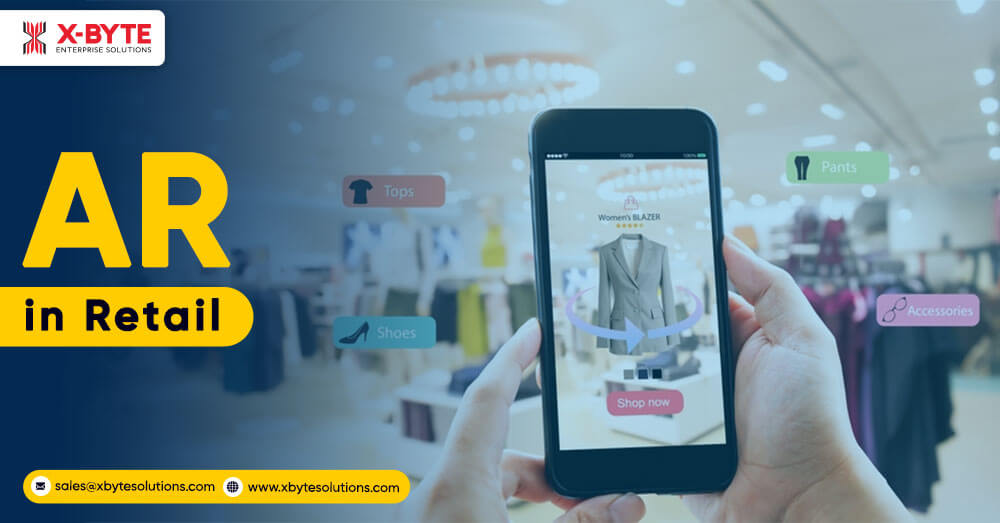
Quick Summary : In the retail industry, technologies like augmented reality (AR) and virtual reality (VR) are creating novel immersive experiences for shoppers and assisting retailers in omnichannel retail operations. The virtual try-ons before shoppers add items to carts eliminate the need for actual physical interaction with products. The benefits of this consumer-facing tech are immense for both shoppers and retailers. Augmented reality is set to drive more profits and innovations in various retail sectors.
The point when Pokemon Go came out in 2016, was indeed the time when augmented reality took off to climb new heights. The game changed the perception towards AR and the cutting-edge tech soon leaped from gaming to shopping. People became interested in what AR could offer them in terms of experience in gaming, shopping, learning, and training. Since then, AR is changing the shopping experience whether the customers are at home (online buying) or in-store. AR brings confidence in product selection and the final buying decision. With immersive interaction with products before purchase, customers can feel the connection (a deeper sense of perception) regarding the product they are buying.
For retailers, AR offers a chance to differentiate themselves from their competitors, enhance CX for their shoppers, and take shopper’s engagement to a new level.
This post discusses in detail the uses cases and applications of AR in various retail sectors, the key benefits of this technology for retailers and shoppers, and the future of AR in retail.
How AR is used in different aspects of retail business?
From NFCs, beacons, and digital payments to AR-enabled try-on mirrors and interactive robots for store navigation, the retail industry has witnessed a massive growth of consumer-facing technologies in recent years. Technologies like AR and VR in retail are changing how shoppers interact with products in the showrooms. For example, Nike allows shoppers to use AR inside their stores. Shoppers can simply scan the item using an AR app and get to see how the shoes will look on their feet in an augmented reality video. Eyewear retailer Warby Parker sells glasses and they use AR to help shoppers try them via app.
- AR Product visualization
- AR store navigation
- AR employee training modules
combines the technologies of augmented reality, mobile, and 3D models for try-ons and interaction with retail products.
in retail guides customers through large stores (retail hypermarkets) or malls to specific products or departments.
in retail simulate real-life scenarios employees might face. Employees can use AR to learn about new products, store layouts, etc.
AR will Make All the Difference Between Old School Vs. Contemporary Retail
AR shopping is not just about visualizing how a product will look on you or your space. Nor it is only about the size or if it fits in your space. It has wider implications that extend beyond space or size and cover the materials and details of the products. For example, while you may view how a piece of sofa will look in your living room or whether it fits in the space or not, it's not just that. You can also visualize the texture, craftsmanship, and material quality of the furniture with AR.
Three Popular Augmented Shopping Experiences
| Try On | Try Out | Interact |
|---|---|---|
|
Virtual Clothing Fitting
Shoppers can use their smartphones or AR glasses to see how dresses look on them. The app scans their body and adjusts the virtual clothing to fit their body shape. |
Furniture Placement
Shoppers can place virtual furniture in their home’s spaces using a smartphone camera. The AR app shows them how a sofa, table, or other furniture items will look and fit in their living spaces. |
Cars Showrooms
Car buyers can interact with a 3D model of a car using an AR app. They can open doors, change the color, and explore the interior features in detail without visiting the car showroom. |
|
Eye Wear Try On
Customers can virtually try on eyewear like sunglasses using a mobile camera and the AR application. The App shows how the eyewear looks on their face and buyers can explore many styles virtually. |
Home Decor Viewing
Customers can use an AR app to visualize how home decor items like vases, paintings, designer mirrors, or wall decor would look on their walls. |
Electronics Showroom
Customers can interact with a virtual model of a gadget & test out features, and interfaces, and see how it responds to touch or voice commands. |
|
Makeup Application
AR apps from beauty brands let users apply virtual makeup to see how different shades of lipstick, eyeshadow, and other cosmetics look on their faces without actually applying the products. No need for physical test products. |
Appliance Placement
Potential buyers can use AR to place virtual appliances, like a refrigerator or washing machine, in their kitchen or laundry room to ensure they fit in the designated space. Check size and style. |
Smart Home Simulations
Shoppers can simulate interactions with smart home devices, such as thermostats, lights, or security cameras with AR apps to see their functionality in a simulated home environment. |
AR Applications in Various Retail Sectors
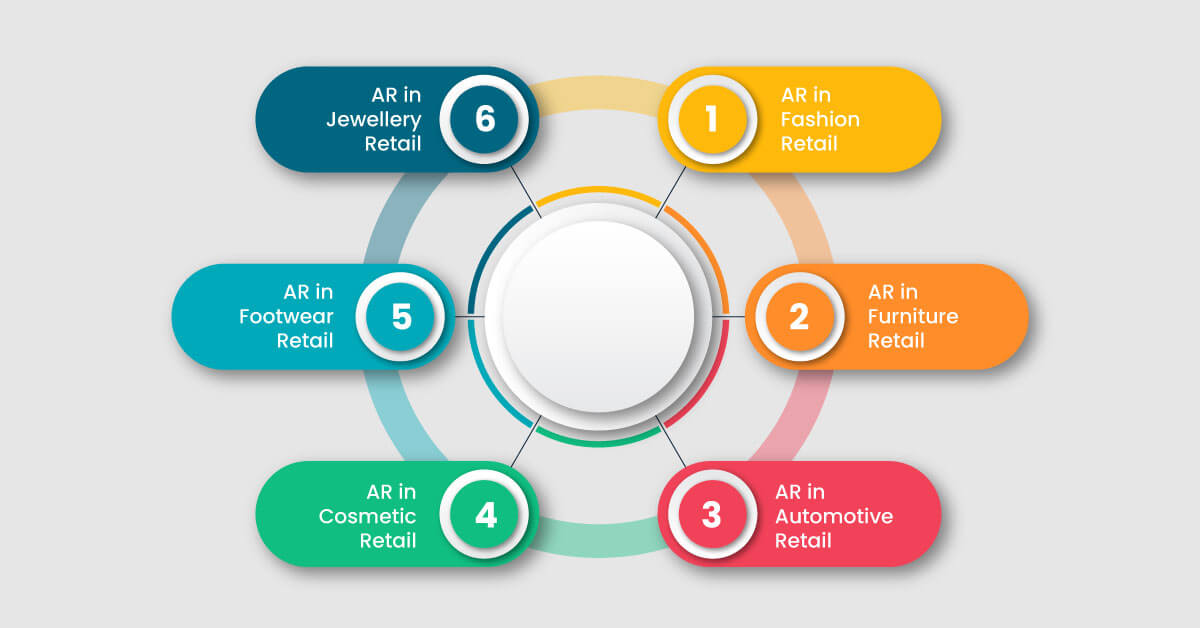
The AR technology in retail is maturing at a decent pace and its adoption is growing rapidly. The developments are impressive. AR enables a shopping experience that was traditionally unknown to retail product buyers. For instance, they can select a product, custom select the type, color, size, or dimension they need, and try it out virtually in any background or environment they want.
Let us see how AR works out for various retail sector types:
AR in Fashion Retail
In fashion retail, virtual try-on is the most popular augmented reality use-case. Retailers’ AR-enabled apps or web platforms can be accessed through smartphones. These apps act like a virtual fitting room with digital mirrors. Most of the fashion product returns reported by ecommerce retailers are due to fitting issues (size problems). The AR-based virtual try-on can solve this problem for online fashion retailers.
Zalando has launched a virtual dressing room. Users can upload their full-body photo on the app and then try on all 22 Jeans items by Zalando.
Augmented reality (AR) benefits fashion retailers and shoppers alike. For retailers, AR enhances customer engagement by providing a fun and interactive shopping experience, keeping visitors on their websites longer and increasing the likelihood of purchases. This technology also bridges the gap between online and in-store conversion rates and AR solutions reduce return rates. Online returns contribute to carbon footprint as logistics is involved in the delivery process.
“We believe that helping people find the right size and improving the try-on experience could both increase conversion rates as well as reduce the rate of returns,” says SnapChat CEO and co-founder Evan Spiegel in an interview given to Vogue Business.
Technologies powering augmented reality in fashion retail:
- 3D modeling
- Machine learning
- Mobile Technology
The tech creates virtual clothing prototypes that are necessary or virtual try-ons.
AR apps trained on ML learn from user behavior and preferences and help in personalizing the experiences.
Smartphone apps with AR accessibility and image capturing (overlay of digital images).
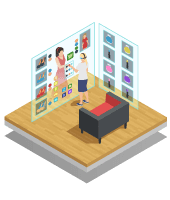
Transform shopping with modern technologies of AR and VR now!
Contact Our experts Contact Our expertsAR in Furniture Retail
Major global furniture brands like Ikea, National Furniture Retailer, EQ3, Wayfair, Heem, and Home Depot are already using AR-integrated apps for their ecommerce platforms. These apps can scale products, adjust the furniture as per room dimensions, and have an astounding up to 98% accuracy. The furniture products can be seen in different styles, lights, and shadows.
IKEA Place makes buying decisions easier… try many different products, styles, and colors in real-life settings with a swipe of your finger. AR and VR will be a total game changer for retail in the same way as the internet. Only this time, much faster,” says Michael Valdsgaard, Leader of Digital Transformation at Inter IKEA Systems.
The Canadian furniture giant EQ3 has introduced WebAR which lets buyers see furniture products in AR view. Buyers can visit the desktop site, select furniture categories and products, and then choose the option ‘View in AR’ that opens a QR code pop-up that can be scanned with a mobile camera for an augmented reality view of the product.
AR in Automotive Retail (Car Dealership Showrooms)
Car showrooms have a range of product variants with multiple configurations and systems. They can't keep all variants in the showroom due to space issues. Augmented reality makes it possible for car enthusiasts to experience and interact with all variants virtually before finalizing the best one for them.
Jaguar Land Rover uses augmented reality in banner ads to provide a 360-degree virtual test drive of its Velar, letting users explore the interior and interact with hotspots for detailed feature information. Hyundai's AR app on iPads helps sales staff showcase the i30 hatchback's features and capabilities, enabling customers to visualize different color and finish options, thus enhancing the sales process and driving conversions.
AR in Cosmetic Retail
The Global AR/VR market in cosmetics & Beauty retail is projected to grow at a CAGR of 25.5% till 2027. AR technology in particular is on the verge of completely transforming the user experience in the beauty and cosmetics retail industry. Interactive and personalized shopping experiences with virtual makeup try-ons, and custom makeup kits trial using AR are promising developments in this field. Consumers can see how different makeup products and shades look on their skin using their smartphones.
Trying different hair colors, eyelashes, and shades of lipsticks without actually applying them is possible with AR apps. Beyond makeup try-ons, AR is used in skin analysis to offer personalized recommendations for makeup options.
L’oreal uses augmented reality to let customers try their makeup products virtually.
AR in Footwear Retail
Augmented Reality (AR) in footwear retail integrates virtual elements with the real world to elevate shopping experiences. AR technology enables customers to try on shoes virtually. Adidas used AR to create an interactive experience for sneaker try-ons. Apps like Wannaby and Nike Fit use it to overlay 3D images of shoes onto the user's feet. With precise foot measurements, down to the millimeter, these apps can recommend the correct shoe size. The accurate size viewing minimizes the risk of ordering the wrong size. Customers can customize their shoes (for colors, materials, and design) using 3D configurators.
Amazon's AR technology enables customers to try on shoes virtually before purchasing. This feature helps in making more informed decisions, potentially lowering return rates.
We’re excited to introduce Virtual Try-On for Shoes, so customers can try on thousands of styles from brands they know and love at their convenience, wherever they are, says Muge Erdirik Dogan, president of Amazon Fashion.
Want to Bring Augmented Reality to Your Retail Store to enhance online shopping of Your Customers?
AR in Jewellery Retail
Shoppers try jewelry designs ranging from earrings try-ons to necklaces and bracelets in high-resolution texture with augmented reality apps. This reduces work for jewelry store owners who can rely on their online website and mobile app to enable virtual try-ons for their jewelry or imitation items.AR apps can detect the body part’s anatomical features or facial dimensions for precise jewelry placement. Shoppers can try thousands of designs which is not possible even if they visit a jewelry store.
AR can also enable product configuration for jewelry, modern modularization, and personalized jewelry items (color, style, finish, coat, monograms, gemstones, etc.). As per MIT Technology Review, major jewelry brands like Cartier and Tiffany use AR to sell luxury jewelry items to Gen Z.
Benefits of AR for Online Shoppers
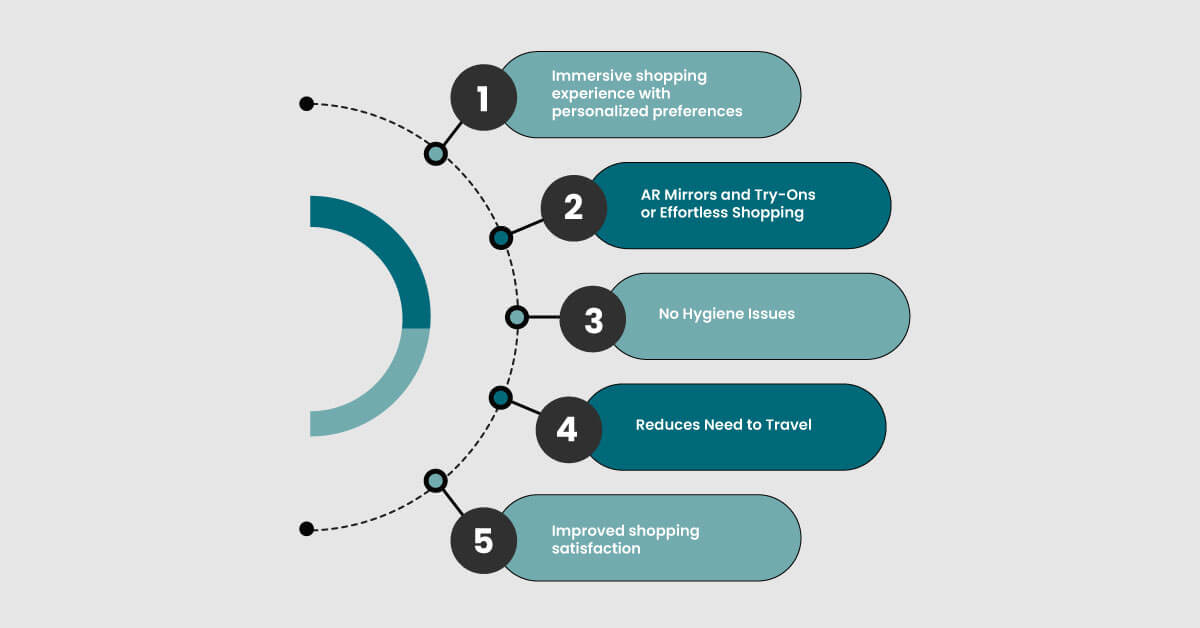
Augmented Reality (AR) has revolutionized the retail shopping experience, offering a blend of enhanced physical and digital interactions that cater to modern consumer needs. Whether shopping in-store or online, AR provides numerous benefits that significantly improve the customer journey.
Here are the key advantages of AR for retail shoppers:
Immersive shopping experience with personalized preferences
With augmented reality, retailers offer faster matches of products to shoppers which is otherwise difficult. Also, shoppers get a chance to comb through multiple product variants from the comfort of their homes using a smartphone. They can custom-create product possibilities with AR.
AR Mirrors and Try-Ons for Effortless Shopping
With AR, the mobile screen is converted into a virtual mirror. This eliminates the need to wait outside busy trial rooms. Shoppers only have to input their face or body image in the app and the app has technology that shows how clothing, footwear, eyewear, or even makeup will look on their body.
No Hygiene Issues
The same products if physically tried by many shoppers may create hygiene issues. AR offers a hygienic alternative to traditional in-store shopping. Virtual try-ons and try-outs help shoppers avoid physical trials of the product. This leads to safer shopping experiences for hygiene-conscious consumers.
Reduces Need to Travel
For certain products like clothing, shoes, and eyewear, consumers generally prefer to try them before buying. Mere images or videos do not offer a complete sense of the feel that shoppers crave before purchasing these items. However, AR in retail has advanced to a level where shoppers can actually visualize and feel how these products look on them or whether their fit and style match their body types. This eliminates the need to physically visit the store, saves travel time, and helps in reducing carbon footprint.
Improved shopping satisfaction
Customers who buy online often face issues like product size or style mismatch with their bodies. This is common with wearables that are ordered online. The reason is that shoppers buy them by seeing the product images and size charts. However, when actual products arrive they might not fit. The returns process is a time waste and reduces shopping satisfaction. AR tryouts provide better confirmation of product size and style than mere images and therefore, reduce the possibility of returns due to size/style mismatch. Hence higher shopping satisfaction for buyers.
Benefits of AR Implementation for Retailers
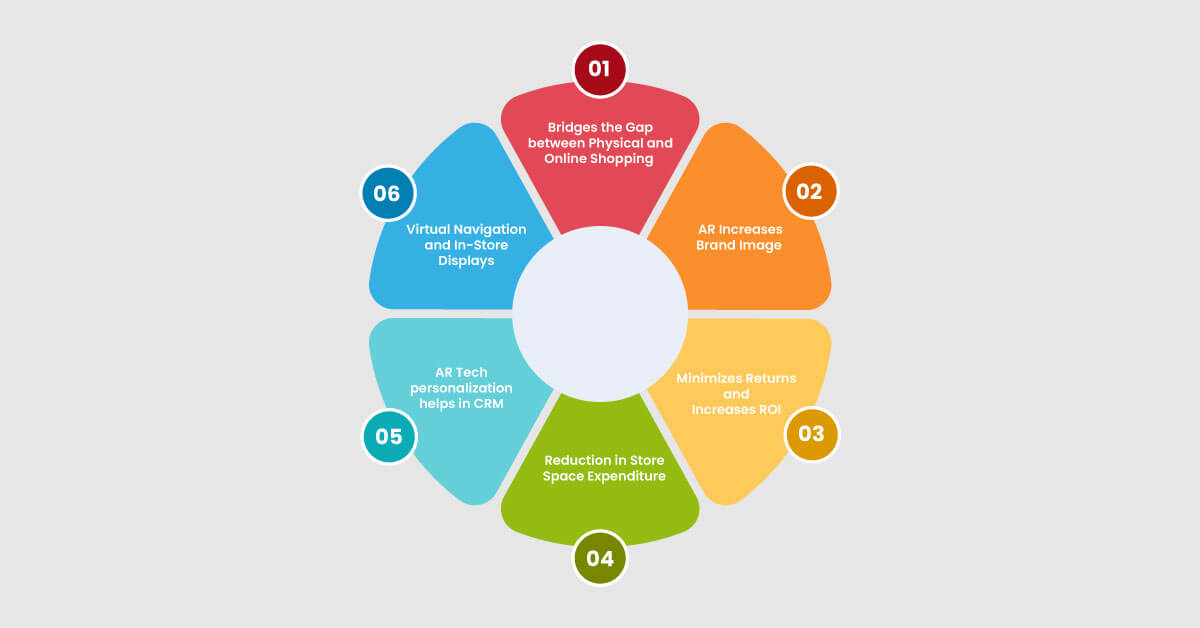
Bridges the Gap between Physical and Online Shopping
Online retailers may find it difficult to compete with retailers with physical stores that also provide added customer interaction with products. AR addresses this concern by providing the same feel and experience as one would have at a retail store. On the contrary, there may be some limitations on trying the products before you buy in physical stores. For example, some packed shirts (formals) are often not allowed for trial before purchase. However, AR won’t have such restrictions.
AR Increases Brand Image
Retailers with omnichannel capabilities that deploy technology like AR are perceived to be highly sophisticated and trustworthy by shoppers. There is a natural boost to the brand image of such retailers. Also, AR can make retailers a global brand as even shoppers from remote areas from different countries and regions can try the products and order.
Minimizes Returns and Increases ROI
As already discussed in this article, high return rates are a hurdle in profits and a customer satisfaction challenge for online retailers. People who have to return products rarely buy again from the same retailers. AR with its try-on capabilities reduces the chances of discrepancy in customer expectation and actual product experience. This translates to higher profits and ROI and lower return costs.
Reduction in Store Space Expenditure
Virtual Fitting Rooms require no space. In integration with popular platforms like Instagram or Snapchat, retailers can implement AR technology and offer virtual fitting rooms for interested buyers. These virtual trial rooms are devoid of physical contact, or hygiene issues and do not require actual space and daily cleaning maintenance. Also, retailers do not have to employ people outside trial rooms to rearrange the garments that are tried.
AR Tech personalization helps in CRM
Augmented technology in retail has a unique benefit. Coupled with AI, the technology can assess customer preferences, buying history, product selection process, favorites, and key choices to provide personalized suggestions for buyers. Personalized offers and suggestions have more chances of conversion. Also, it helps build loyalty and affinity towards your retail brand.
Virtual Navigation and In-Store Displays
Augmented Reality (AR) navigation systems ease shoppers’ life inside the store. In physical retail stores, the AR-enabled app can guide shoppers through store layouts, aisles, and departments and help them locate their required items. This unburdens retail staff and is also a boon for those introverted shoppers who tend to avoid interaction with staff and prefer self-service.

Impress your shoppers with your custom AR app created by integrating modern tools and technologies!
Get Quote Now! Get Quote Now!Future of AR and its Impact on In-store Shopping
The retail industry, which is always welcoming new innovations and is one of the early adopters of the latest launches, soon started using AR to provide unique experiences to their customers and also for marketing purposes. The growth of AR in the retail industry since then has been gradual and highly impressive. The projections from Allied Market Research suggest a CAGR of 41.4% for AR in retail.
Augmented reality is bound to take personalization, Customer experience (CX), and engagement with retail brands to a new level in the near future. ARetail is not a buzzword anymore, it is a blatant reality. With the growing usage of AR in eCommerce, the complete transition from traditional retail to AR-powered retail won’t take much time. AR also works at its best inside the brick n mortar stores as a reliable and engaging immersive technology.
The future for retailers who quickly implement this tech in their stores is bright.
Conclusion
Retailers can benefit a lot from implementing AR and VR technologies. Not discovering these futuristic techs for their omnichannel retail business means lagging behind in the highly competitive retail industry. As augmented reality in retail is the future of shopping, you should not wait for implementation. A few years later if you are not using AR in your retail stores for example, garment stores, electronics, furniture, gift shops, jewelry shops, and many more others, then you will be tagged as old school retailer.
If you are looking for augmented reality development services with expertise in ARkit development, location-based AR, AR-based apps for store navigation, or AR shopping apps, then X-Byte Enterprise Solutions can be your go-to partner. X-Byte is a full-stack AR/VR development company with years of expertise in building customer-facing software solutions for the retail industry.
Frequently Asked Questions
-
What is augmented reality in eCommerce?
Augmented reality (AR) in eCommerce means providing online shoppers with AR application-based access to the online retail store where customers can select products and see or try them using immersive AR. It blends digital elements into the real world so that shoppers can interact with eCommerce products that they want to buy.
-
What are the challenges of implementing AR
in retail?
Implementing AR in retail comes with a few challenges such as an initial investment for AR app development, the learning curve for staff, ensuring flawless implementation, ROI worries, etc. However, with a reliable AR development company, you will not be overwhelmed by these challenges. In fact, the long-term benefits comfortably surpass all the initial challenges retailers might face.
-
What are the best practices for using AR in retail?
Best practices for using AR in retail include creating user-friendly and intuitive interfaces, ensuring high-definition 3D modeling, protecting shopper’s data privacy, and maintaining industry standards for the development of AR apps.
-
How to get started with AR for your retail business?
To get started with AR for your retail business, begin by identifying the specific areas where AR can solve shopper’s pain points or improve the shopping experience. Partner with experienced AR developers to create a robust and scalable AR solution.
-
What is the cost of implementing AR in retail?
The cost of implementing AR in retail depends on the complexity of the technology, the level of customization, and the scale of the deployment. Basic AR solutions can start at $20000 dollars, while more sophisticated AR apps may cost up to $300000 and more.
